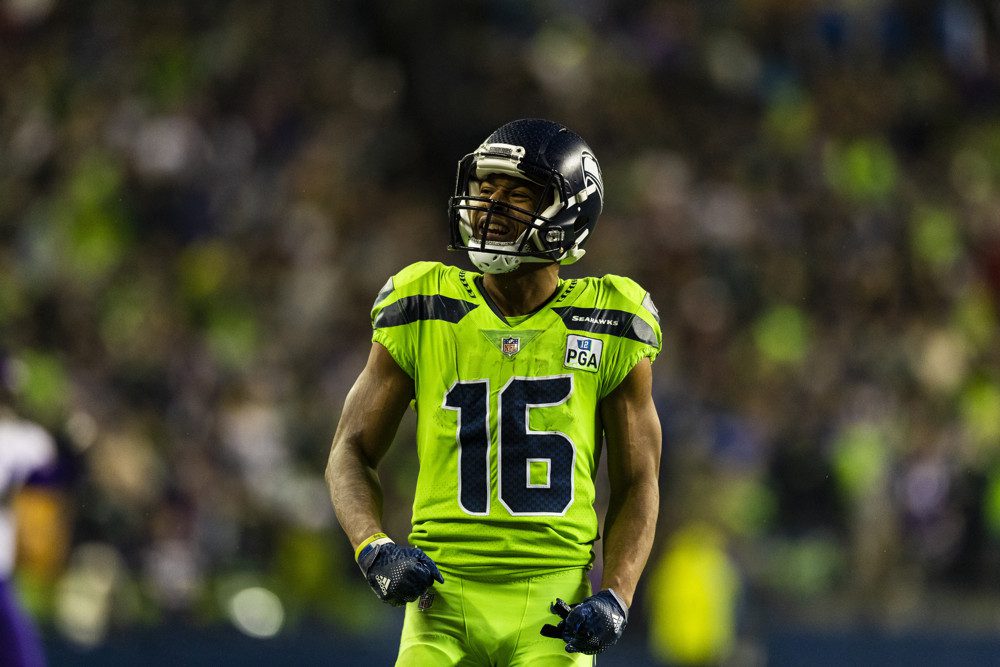Last updated: July 27th at 10:32pm ET.
Seahawks 2014-2018 Offensive Profile
2014-2018 Pass Attempts Rank: 32nd, 28th, 18th, 16th, 32nd
2014-2018 Rush Attempts Rank: 2nd, 3rd, 20th, 21st, 2nd
2014-2018 Play Volume Rank: 14th, 16th, 19th, 17th, 15th
2014-2018 Yards Per Play Rank: 6th, 5th, 12th, 17th, 16th
Unaccounted for Targets from 2018 (Rank): 142 (12th)
Unaccounted for Carries from 2018 (Rank): 115 (14th)
Projected Starting Lineup
QB: Russell Wilson
RB: Chris Carson
WR: D.K. Metcalf
WR: David Moore
SLWR: Tyler Lockett
TE: Nick Vannett
LT: Duane Brown
LG: Mike Iupati
C: Justin Britt
RG: D.J. Fluker
RT: Germain Ifedi
Seahawks Passing Game
Russell Wilson, incredibly, overcame the Seahawks’ staunch run-game commitment to finish his seventh straight season as a fantasy QB1 by way of a career-best 8.2% touchdown rate that was inarguably impressive but puts Wilson in jeopardy of potentially-sharp 2019 regression. OC Brian Schottenheimer was intent on establishing the run, resulting in Wilson’s fewest pass attempts (427) since his rookie year (393). Wilson does project for positive regression on the ground after scoring zero rushing TDs for the first time in his career, however, and Wilson has been an outlier against normalcy his entire life. Wilson has never missed an NFL game, and he has never finished below QB11 in fantasy scoring. In season-long leagues, he’s a high-floor pick in the double-digit rounds whose ceiling is fair to question. Difference-making DT Jarran Reed‘s six-game suspension increases the likelihood Wilson throw more in 2019.
Tyler Lockett paid off as my highest-owned 2018 best-ball pick, parlaying just 70 targets into career highs in catches (57), yards (965), and touchdowns (10) while finishing No. 17 among 96 qualified wide receivers in yards per route run (2.10). Lockett was especially dominant in the slot, where he caught 26-of-29 targets for 454 yards and five TDs. Lockett’s slot success is most notable due to Doug Baldwin’s retirement, rendering Lockett Seattle’s new primary slot option. An elite playmaker with the ball in his hands, Lockett starred on kick and punt returns his first three years in the league and is now Wilson’s clear No. 1 receiver. Lockett can’t sustain scoring a touchdown every seventh target, but his volume has big room for growth, and he easily has the best rapport with Wilson among Seattle’s pass catchers.
D.K. Metcalf slipped to the 64thoverall pick due to concerns with his injury history and limited route tree after posting miserable short-shuttle and three-cone times and almost strictly running goes and screens in Ole Miss’ frustrating offense. Metcalf runs 4.33 at 6-foot-3, 228, however, and his 1.48 ten-yard split was fastest among all players invited to the Combine. Metcalf broke his foot as a freshman and missed seven games with a neck injury as a redshirt sophomore. Nevertheless, his size-speed combination and ability to win at the line of scrimmage make Metcalf a perfect fit to work outside in Seattle’s run-first attack. I likened Metcalf to Martavis Bryant before the draft, and am willing to target him in the double-digit rounds as a big-play magnet defenses will struggle mightily to cover when Wilson improvises.
Seattle’s No. 3 wideout job is up for grabs with incumbent David Moore, fourth-rounder Gary Jennings, holdover Jaron Brown, and seventh-round pick John Ursua at the forefront of the competition. SPARQ freak Moore flashed big-time playmaking ability last Weeks 4-11, only to vanish the rest of the way and play just 12 snaps in Seattle’s playoff loss. Jennings was an exciting vertical slot receiver at West Virginia and blazed 4.42 at 6-foot-1, 214 in Indianapolis. A separation machine in the Big 12, Jennings was also clocked as one of this year’s fastest Senior Bowl invitees by the NFL’s new Zebra technology. Brown failed to climb last year’s depth chart. Coach Pete Carroll has talked up Ursua as a Doug Baldwin clone. Albeit with limited upside on the NFC’s run-heaviest team, Seattle’s third-receiver battle takes on increased importance due to the team’s shortage of running back targets and weak talent at tight end, where Will Dissly, Nick Vannett, and Ed Dickson will vie for playing time.
Seahawks Running Game
Coming off a season where they led the NFC in rushing attempts, Seattle’s backfield is a fruitful source of fantasy opportunity enhanced by Mike Davis’ departure. A quietly significant early-down committee back and third-down specialist on last year’s team, Davis accounted for 146 touches and 38% of the Seahawks’ running back snaps. Chris Carson deserves to return at feature back after ranking No. 5 in the NFL in rushing yards (1,151), No. 15 among 47 qualified backs in Success Rate (51%), and No. 6 among 56 in yards after contact per rushing attempt (3.36). Carson underwent an offseason knee scope but was cleared for the start of camp. He is an every-draft pick in the fifth round.
Rashaad Penny deserves more opportunities after ill-advisedly adding 20 pounds and struggling for rookie playing time, even as Penny averaged more yards after contact (3.40 to 3.36) than Carson and 4.9 yards per carry. Penny cut back to his natural 220-pound weight this offseason and will undoubtedly get his wish in Davis’ absence on the NFC’s most run-committed team. Penny was an obvious 2018 fade, but he’s more interesting this year, and drafting both of Seattle’s top backs shouldn’t be ruled out. This team runs so much Carson will be an RB2 and Penny a valid flex option each week with upside for more.
2019 Vegas Win Total
Seattle’s 2019 Win Total is 8.5, a mark they’ve eclipsed in seven straight years despite failing to optimize Russell Wilson, whose career 6.0% touchdown rate suggests he’s one of the best quarterbacks of all time. The Seahawks remain deficient around him beyond Tyler Lockett, however, and Frank Clark’s loss weakens penetration up front, exacerbated by underrated DT Jarran Reed‘s six-game suspension. The Seahawks are a 7-9 win team I’m tentatively taking the under on.



